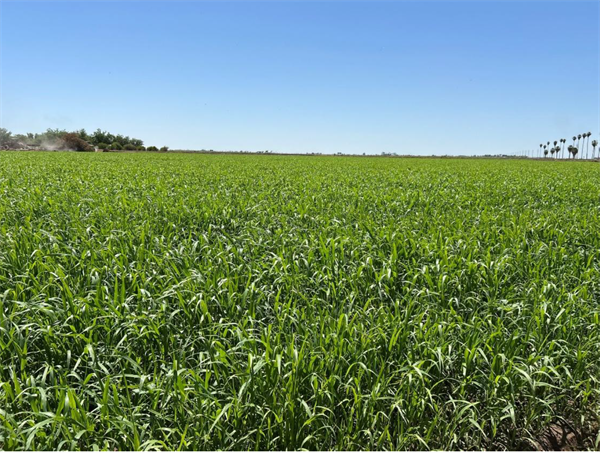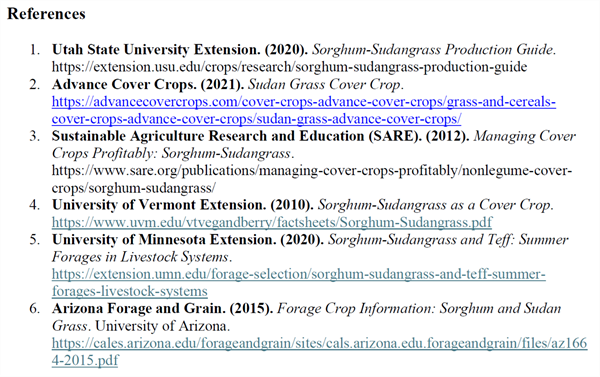
In several previous issues of this UA Vegetable IPM Newsletter (Silvertooth a,b, and c; 2025), I have presented a melon (Cucumismelo ‘reticulatus’ L.) crop phenology model (Figure 1; Silvertooth, 2025a) based on heat unit accumulations (86/55 ºF thresholds) and I have chronicled the development of the 2025 spring melon crop in the lower Colorado River areas at several stages of growth.
Referring to the data from AZMET for several locations in the Yuma area (Link to AZMET) , we can obtain the HU accumulations from 1 January 2025 for a set of four possible 2025 planting dates that are listed in Table 1. The HU accumulations from 1 January 2025 to 15 May 2025 for these sites are listed in Table 2.
The HU accumulations after planting (HUAP) for these four possible planting dates for three Yuma area locations to 15 May 2025 are shown in Table 3. The HUAP values in Table 3. These HUAP values are simply the difference between the values in Tables 1 and 2 between 15 May and the planting date.
As an example for the Yuma Valley, HU accumulations for the 15 January 2025 planting date from 1 January was 73 HU. The HU accumulation from 1 January to 15 May was 1419 HUs. Thus, the HUAP = 1419 – 73 = 1346 HUAP for this case.
The information in Table 3 can help serve as a reference to check for melon crop development in the field against this phenological model in Figure 1. Since the 2025 spring melon season has been relatively cool, based on long-term averages, some producers and field personnel have noticed a later maturity of the crop based on the calendar. However, the early planted crops were just ready to begin harvest in mid-May, which is consistent with the HU-based phenological model (Figure 1).
Some variation exists among fields with different melon types and varieties but this phenological model is tracking the general progress and development of the 2025 spring melon crop in the desert Southwest and this has been a good season to demonstrate this model.


Table 1. Heat unit accumulations (86/55 ºF thresholds) after 1 January 2025 on four
possible 2025 planting dates utilizing Arizona Meteorological Network (AZMET) data for
each representative site. †
†AZMET data for the Yuma Valley, Yuma North Gila Valley, and the Roll area of the Gila
River Valley can be accessed via the following link: Link to AZMET

Table 2. Heat unit accumulations (86/55 ºF thresholds) after 1 January 2025 to 15 May
2025 utilizing Arizona Meteorological Network (AZMET) data for each representative site.

Table 3. Heat unit accumulations (86/55 ºF thresholds) after planting (HUAP) from four
possible 2025 planting dates and three sites in the Yuma area on 15 May 2025 utilizing
Arizona Meteorological Network (AZMET) data for each representative site. Each value
is rounded to the next whole number. Note: the values in Table 3 are determined by
taking the difference between the HUs for each representative site and four planting
dates from corresponding values in Tables 1 and 2.

Figure 1. Melon (cantaloupe) phenological development model expressed in Heat Units
Accumulated After Planting (HUAP, 86/55ºF).
I hope you are frolicking in the fields of wildflowers picking the prettiest bugs.
I was scheduled to interview for plant pathologist position at Yuma on October 18, 2019. Few weeks before that date, I emailed Dr. Palumbo asking about the agriculture system in Yuma and what will be expected of me. He sent me every information that one can think of, which at the time I thought oh how nice!
When I started the position here and saw how much he does and how much busy he stays, I was eternally grateful of the time he took to provide me all the information, especially to someone he did not know at all.
Fast forward to first month at my job someone told me that the community wants me to be the Palumbo of Plant Pathology and I remember thinking what a big thing to ask..
He was my next-door mentor, and I would stop by with questions all the time especially after passing of my predecessor Dr. Matheron. Dr. Palumbo was always there to answer any question, gave me that little boost I needed, a little courage to write that email I needed to write, a rigid answer to stand my ground if needed. And not to mention the plant diagnosis. When the submitted samples did not look like a pathogen, taking samples to his office where he would look for insects with his little handheld lenses was one of my favorite times.
I also got to work with him in couple of projects, and he would tell me “call me John”. Uhh no, that was never going to happen.. until my last interaction with him, I would fluster when I talked to him, I would get nervous to have one of my idols listening to ME? Most times, I would forget what I was going to ask but at the same time be incredibly flabbergasted by the fact that I get to work next to this legend of a man, and get his opinions about pest management. Though I really did not like giving talks after him, as honestly, I would have nothing to offer after he has talked. Every time he waved at me in a meeting, I would blush and keep smiling for minutes, and I always knew I will forever be a fangirl..
Until we meet again.
Last week, we initiated an on-farm demonstration of soil steaming of the season with our self-propelled steam applicator. The machine is designed to inject steam into the soil and raise soil temperatures to levels sufficient to kill weed seed and soil borne pathogens (roughly 150°F for > 20 minutes). After the soil cools (< ½day), the crop is planted into the disinfested soil.
In this trial, we are examining the viability of soil steaming for controlling weeds in spinach at the field scale level (plot size > 1/3rd ac). The machine performed well in that it was able to reach target soil temperatures at reasonable travel speeds (> 0.25 mph) in cold soil (roughly 50°F), provide uniform temperature distribution across the bed and form nicely shaped beds suitable for subsequent planting. Stay tuned for reports of weed control efficacy, crop yield and overall profitability as compared to the grower standard.
If you are interested in seeing the machine operate at the field scale level on a commercial farm, we are conducting additional trials this week! Please contact me for further information.
Fig. 1. On-farm demonstration of a self-propelled steam applicator for weed and
diseasecontrol video. We are conducting additional trials this week. Contact me if
you are interested in seeing it.
Acknowledgements
This project is sponsored and funded in part by the Arizona Specialty Crop Block Grant Program and the Propane Education and Research Council (PERC). We greatly appreciate their support.
According to some authors "the human brain can process images up to 60,000 times faster than words"1. So, I decided to share images of some of the onion herbicide tests we did at the Yuma Ag Center last season hoping you find them interesting as the season progresses. As you know the products tested could respond differently under different environments. Also some of these trials are done searching for new alternatives, therefore products are not registered.

Biological control is an important IPM tool globally. This pest suppression technique is especially important for managing pests in organic crop production. There are various biological control techniques, including conservation biological control, classical biological control, and augmentative biological control. Conservation biological control is the practice of providing habitat to support abundant populations of naturally occurring arthropods that attack crop pests. However, classical biological control and augmentative biological control involve the release of arthropod predators and parasitoids, usually non-native, into the field or greenhouses. This article focuses on conservation biological control.
The contribution of native beneficial insects to pest control has been estimated to be approximately $4.5 billion annually in the United States alone. However, the benefits of beneficial insects areoften overlooked. Research conducted across the country has shown evidence that conserving natural habitats leads to an increase in beneficial arthropod populations and a reduction in pest problems on farms. Beneficial arthropod predators and parasitoids often rely on natural or semi-natural areas adjacent to the field for their persistence. Between growing seasons, these natural and semi-natural areas provide alternative food sources, overwintering, and nesting habitats for natural enemies, thereby promoting their populations. To complete their life cycle, natural enemies require more than just prey or hosts; they also need refuge sites and alternative food sources.
Neighboring natural and semi-natural habitats serve as sources of natural enemies during the growing seasons to suppress crop pests. The establishment of wildflower margins around crop fields increases the abundance of beneficial insects that search for pollen and nectar. For example, many adult parasitoids sustain themselves with pollen and nectar from nearby flowering plants while searching for hosts. Most natural enemies do not disperse far from their overwintering sites; access to permanent habitat near or within the field gives them a jump-start on early pest populations.
Farms with diverse and dense populations of natural enemies are likely to exhibit the following characteristics:
- Have small fields surrounded by natural vegetation.
- Composed of diversified cropping systems and plant populations in or around fields include perennials and flowering plants.
- Crops are managed organically or with minimal agrichemicals.
- Soils are high in organic matter and biological activity and, during the off-season, covered with mulch or vegetation.

Figure 1. Syrphid fly feeding from sweet alyssum flowers.

Figure 2. Mix flowers planted on strips between rows of celery to provide food and
shelter for natural enemies.
In the arid farming systems of Yuma, Arizona, growers often face the challenge of sustaining soil health and productivity between intensive winter vegetable cropping seasons. One effective, science-backed strategy to support this transition period is the use of Sudan grass (Sorghum Sudanese) as a summer cover crop (Figure 1).
Sudan grass grows rapidly in hot, dry conditions, making it well-suited for our desert climate. Its value extends beyond simple ground cover; this warm-season annual plays a pivotal role in enhancing long-term soil health, improving field conditions, and supporting environmental resilience.

Figure 1. Sudan grass in the Valley Research Center at the University of Arizona, Yuma
Agricultural Center, Yuma, Arizona.
Soil Health Benefits
Sudan grass contributes significant organic biomass, which boosts soil organic matter and fuels microbial life (USU Extension, 2020). Its deep root system also improves soil structure by loosening compacted layers and enhancing water infiltration (Advance Cover Crops, 2021).
Natural Weed and Disease Suppression
Its dense canopy shades out summer weeds, while allelopathic compounds such as sorgoleone help suppress soil-borne pathogens (SARE, 2012). As a rotation crop, Sudan grass disrupts pest and disease cycles common in lettuce systems, including Fusarium wilt (UVM Extension, 2010).
Environmental and Water Efficiency
As a living cover, Sudan grass reduces dust, protects against erosion during monsoon events, and uses water efficiently compared to cash crops (Arizona Forage and Grain, 2015).
Economics and Future Crop Performance
Though not a direct income generator, Sudan grass has low input requirements and can be used as forage if needed (UMN Extension, 2020). Importantly, it leaves behind a biologically enriched soil bed that benefits subsequent crops like lettuce, often resulting in better stands and vigor (USU Extension, 2020)
Bottom Line
Sudan grass offers growers in the desert Southwest a strategic tool to enhance their production systems while supporting sustainability. By bridging the gap between seasonal crops, it transforms summer downtime into an investment in soil productivity and environmental stewardship.
